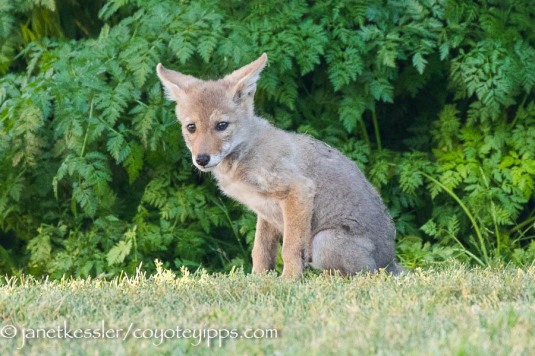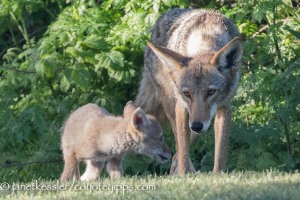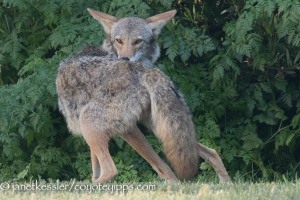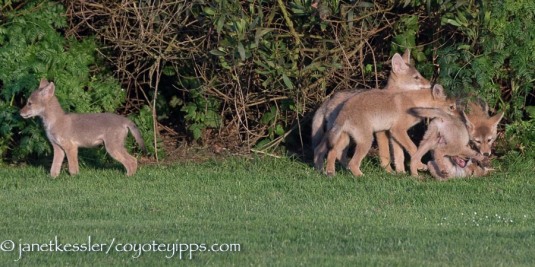There wouldn’t be a fight, generally speaking. Let me show you why I say so.
Here’s what is a stake for the coyote when a German Shepherd Dog gets interested in a coyote.

Here’s team Mom and Dad coyote. That’s Mom at the left of the frame. Big. Irritable, look at her ear, end stage otitis I believe.

Here’s Dad charging my dog and me. Yeah, its a bluff and we were on the other side of a chain link fence.

Now, the following photograph, I did not take, it was taken by a friend of mine, Janet Kessler in a San Francisco park.

[Edit: I want to emphasize that the dog pictured above was not injured. It returned to its owner, was put back on its leash, its owner talked to Janet, and then went home with a good education. Janet Kessler is all about education.]
Coyotes have skin in the game. That particular German Shepherd-ish Dog is someone’s pet. It lives in one world. Coyotes live in the real world and take care of real business every day. In the above photo, no real dirty work was required. The German Sheperd-ish Dog is a pet and totally out of its element. I’m talking typically. The above shot was part of a series. The other shots showed a chase and some maneuvers. The coyote danced its way into the position we see. The coyote has practiced all its life on this stuff. It isn’t like in a dog park.
Generally, although a German Shepherd Dog has the weight advantage, coyotes with their experience and situational intelligence have a considerable advantage over a German Shepherd Dog. The dog pictured has never seen real action. Nor has it really seen a very motivated opponent. The stuff dogs argue about? Who gets to keep the ball. Coyotes can puff up and make themselves look way bigger than their average of about 26 to 30 pounds out here in the West. There’s no hint of play in their demeanor when their family’s safety is at stake. I think it is safe to say that because of the size of a German Shepherd Dog, coyotes don’t want to eat it. They don’t rank it as prey, it’s an interloper. Coyotes deal with interlopers a lot. That pictured dog? He’s getting it in gear to run away at full speed. He’s a real chicken, and needs to be. He tried to pick on someone smaller, and he got told.
Coyotes intrude on each other’s territory all the time. They test one another looking for fun or for the chance of a gain. At stake is their food, their mate, and their children. I’ve read from studies that unlike wolves, coyotes have one coyote defend their territory. Wolves I’ve read just kill intruders. Coyotes? Their strategy is to give an intruder a thrashing. Enough so that an intruder won’t forget. With my coyotes, Mom was there as backup and Dad did the work.
Here’s a real contender. Note it looks like he had lost an eye, maybe in a fight. He’s in his prime, and he hooked up for life with one of Mom and Dad’s daughters. After he came on the scene, I didn’t see Mom and Dad again. They had grown old and had aches and pains. The last time I looked, a few years ago, it seemed that not much was known about coyote inter-generational transfers of territory. In this one observation of mine, it looked pretty ugly.

And in urban and suburban settings, coyotes don’t want a fight. They huff, puff, and bluff to warn an intruder away. And they will run away. That can be a rope a dope, a run for a better site for parrying, or to keep on distracting a dog until it gets worn out. They don’t want contact. They don’t want to be injured. But a dog? They tire sooner, or get called back by their owner. The dogs don’t know the territory as intimately as a coyote has to know its own territory. For a pet dog, they just don’t have game. The coyotes I’ve seen seem to have most dogs figured out. To a wild coyote, a dog in coyote territory acts untutored in the ways of the wild.
[Posting written by Charles Wood. Visit Charles Wood’s website for more coyote photos from LA: Charles Wood. His work is copyrighted and may only be used with his explicit permission.]
[Note from Janet: The Shepherd could sustain a nip to the haunches if he were persistent in going after the coyote. Note that the nip is a reinforcing *message* to the dog to “leave me alone and get out of here”. It is not meant to maim the dog.]




































 The runt in a litter, when there is one, is the smallest and sometimes the weakest pup. Their biggest disadvantage is that, because all the other pups are larger than them, they have a harder time competing for Mom’s milk. It turns out that getting one’s fair share of milk during the first 48 hours after birth is very important: only that very initial supply of milk contains colostrum which is loaded with antibodies which primes the pups’ immune systems, without which they could be more vulnerable to illnesses.
The runt in a litter, when there is one, is the smallest and sometimes the weakest pup. Their biggest disadvantage is that, because all the other pups are larger than them, they have a harder time competing for Mom’s milk. It turns out that getting one’s fair share of milk during the first 48 hours after birth is very important: only that very initial supply of milk contains colostrum which is loaded with antibodies which primes the pups’ immune systems, without which they could be more vulnerable to illnesses.




















